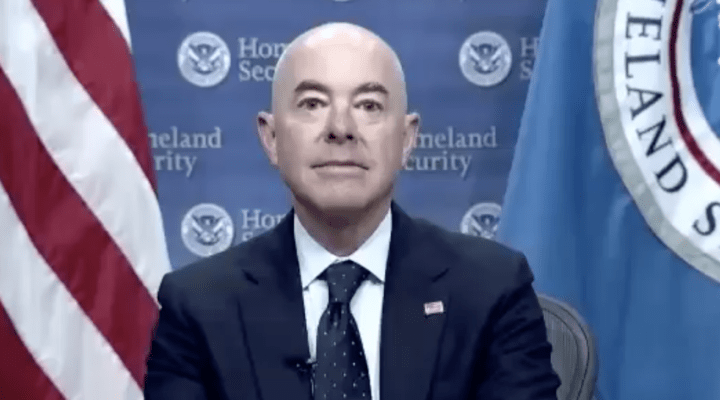More astounding than the dysfunction of the U.S. immigration system is that no one can figure out how to restore it to working order, a top Biden administration official said.
“It is just stunning how there is unanimity with respect to the broken condition of our immigration system and a failure to fix it,” Alejandro Mayorkas, secretary of the Department of Homeland Security, said during the first day of the 18th annual Immigration Law and Policy Conference held online Sept. 27-28 and co-sponsored by the Catholic Legal Immigration Network, the Migration Policy Institute and the Georgetown University Law Center.
Rather than deliver a keynote address, Mayorkas responded to an hour-long question-and-answer session that covered broad immigration issues, the administration’s continuing use of Title 42 to deport asylum seekers without due process, the emergency relocation of Afghan refugees, recent surges of migrants at the southern border and the role of the COVID-19 pandemic in exacerbating global migration.
“It is just stunning how there is unanimity with respect to the broken condition of our immigration system and a failure to fix it.”
“The world is still reeling from and in the pandemic, and the downturn of economies has caused people in greater numbers to leave their homes,” Mayorkas said.
That pandemic-induced trend is visible globally but especially in the so-called triangle nations of El Salvador, Guatemala and Honduras, where economic devastation is creating waves of migrants being encountered at the U.S.-Mexico border at an average rate of 7,500 a day, he said.
“So much of the increase in numbers is, in our view, a product of economic desperation created by a hemispheric downturn in financial well-being.”
When asked to defend President Biden’s continued use of the Trump-era Title 42 rule, Mayorkas explained that it does not represent White House immigration policy. Instead, the public health rule is a response designed to prevent further outbreaks of COVID-19 during the ongoing spike of the Delta variant.
Title 42 is an obscure provision of law the Trump administration activated in the early days of COVID-19, immediately sending away would-be asylum seekers with no investigation or due process. Critics of the Trump administration saw this as a ruse to further Trump’s strong anti-immigrant views, and they have been equally critical of Biden for not ending the practice.
“Operationally, we are confronted with a population of people that, as a general matter, have a rate of illness of approximately 20%, and they arrive in between the ports of entry and must be placed in congregant settings, which could precipitate a significant spread of the disease,” Mayorkas said.
The U.S. system for processing asylum seekers and others crossing the border simply isn’t built for quarantining large numbers of people, he added.
The U.S. system for processing asylum seekers and others crossing the border simply isn’t built for quarantining large numbers of people, he added.
A federal court earlier this month ordered the administration to stop using Title 42 by Sept. 30, a contingency for which the U.S. has been preparing with its “partners to the south,” the secretary said.
Federal officials had hoped the federal health code provision could be abandoned as the pandemic waned earlier this year, Mayorkas said, but added that the surge of the Delta variant necessitated continued use of the rule, a move confirmed by the Centers for Disease Control in July.
Mayorkas objected to the wording of a question about the administration’s “loosening of enforcement” in the interior of the nation by recently allowing an additional 12,000 to 13,000 migrants to remain in the U.S. as they await immigration court hearings.
“What I would say is we are implementing fairness and justice in the interior enforcement … after four years of a regime that would not be characterized by those two terms,” he replied.
Nor is the administration concerned that the move may encourage even more migration, because it is “messaging to the diaspora community the fact that they should not take the perilous journey to come here.”
Along with these challenges, the U.S. now is scrambling to assimilate more than 60,000 Afghan refugees who fled the nation as it was overrun by the Taliban in August.
“What I would say is we are implementing fairness and justice in the interior enforcement … after four years of a regime that would not be characterized by those two terms.”
Vetting of the Afghan allies is being handled at overseas locations using biometric and biographic screenings and through secondary screenings at Dulles International airport in Virginia and Philadelphia International Airport in Pennsylvania, the two ports of entry for the refugees, Mayorkas said.
“And we have, in fact, returned a few people to other countries and we have placed a few people in removal proceedings. It’s been a minimal number.”
Much bigger number problems the U.S. Citizenship and Immigration Services face are the 1.2-million green card backlog, as well as the new 125,000 refugee cap announced by the Biden administration for fiscal year 2022. Green cards are permanent residency documents.
The federal government is working through the backlog of permanent residency card applications and is consulting with refugee resettlement agencies to handle an expected influx of global refugees, he said.
Mayorkas added that “COVID has been an extraordinary driver” of the backlog, which he has been “saddened to see.”
Related articles:
Pressure mounts on White House to rescind another Trump immigration policy


